I recently came across this excellent video by Electronics YouTuber "Big Clive" about the differences between UV-A, UV-B and UV-C light. If you have a minute (or 24) then you should check it out; it's pretty interesting!
If you don't have half an hour to learn about the UV spectrum, I guess I don't blame you, but here is the gist of the video: There are a lot of different types of fluorescent lamps available online that are all labeled as "UV" lamps. Some of them are what you might traditionally call "black lights," but some of them are slightly more sinister. Big Clive relays the story of a HYPEBEAST event where an uninformed designer used UV-C lamps in a number of booth fixtures because of their admittedly very cool and futuristic, ghostly blue glow. This had the unfortunate side effect of leaving many in attendance with sunburn and welder's flash...from attending a fashion event.
You see, as Clive explains in the video, UV light comes in a few different flavors. The first is UV-A at 315-400nm, which is not particularly harmful and is the kind of radiation that makes up most "black light" effects. Next is UV-B at 280-315nm, which is the kind that's largely responsible for sunburn (and, not surprisingly, is the kind of UV generated by tanning lamps). And then there's UV-C at 100-280nm, which is kind of nasty. UV-C is used for sterilization in air and water circulation systems, and can cause skin burns and eye damage. It's not a problem for us in nature because it can't penetrate the atmosphere to reach us from the sun. The fluorescent bulbs that are designed to radiate UV-C have to be made from quartz glass just so the light can get out; normal glass tends to be fairly opaque to UV-C. In the video, Clive shows off a few different kinds of fluorescent bulbs that are available cheaply on eBay that generate different kinds of UV light.
Around this same time, someone at the office was getting rid of a small fluorescent inspection light. This is a sort of battery-powered thing that illuminates one 6" tube. I snatched it up and immediately started to convert it from running on alkaline batteries to running on rechargeable lithium batteries. After all, who has a bunch of "C" batteries laying around anymore?
My first step was to pull the enclosure apart and connect the battery contacts directly to my bench supply. This way, I could vary the input voltage and find out what the circuit would tolerate. Of course I could count how many batteries were supposed to fit in there and multiply it by about 1.5VDC, and in fact I did in order to figure out a starting point. What I was really interested to find out, however, was whether it would be happy to operate at some multiple of 5V, so that I could use one of our Charger/Booster Boards to run it on a lithium ion battery. Luckily, there was already a cool white bulb in the lamp so I could tell whether the circuit was actually striking the bulb and, surprisingly, it had no trouble at all striking at 5V. The lamp may not be as bright as if it were running at a little higher voltage, but it's plenty bright enough. I had to make a few subtle modifications to the enclosure to get the giant 6AH battery to fit, and also to allow the insertion of a USB cable for charging, but it all went back together with no signs of tampering.
As for the circuit that allows a handful of alkaline batteries to power a fluorescent light bulb, here's a look at the board that was in this lamp:
It looks to me to be an application of this classic circuit:
Image Courtesy of Next.GR
This is a very simple lamp driver inverter. The transistor is used to set up an oscillator, which switches current from the batteries across two return paths, starting from the center tap of a transformer winding, back through one side and then the other. This switching back and forth on the primary winding produces as alternating current on the secondary, or output, winding of the transformer. If the transformer is wound correctly, the output voltage will be much higher than the direct current found on the primary side.
After watching the Big Clive video on UV lamps, I had already ordered a few bulbs in the correct size for this lantern: A "BLB" or Blacklight Blue bulb as well as a UV-C sterilizing bulb. Together, they ran me less than $20 shipped from an online, specialist light bulb store. I was excited to find that both of these bulbs worked fine in my slightly under-powered fixture!
But now I really wanted some way to keep all of these different types of bulbs at hand, so I designed a clip in Fusion 360 that would hold the fluorescent tubes on the side of the enclosure. Essentially, each clip is just a pair of cylinders with an arc missing whose inner diameter exactly matches the outer diameter of the tubes. Two of them would be glued in place on the side of the inspection light and would allow me to quickly clip and unclip a tube whenever I needed. This is what I came up with:
I threw it on the TAZ 5 3D Printer and in about an hour I had a pair of finished clips. To get the alignment right, I clipped in both of my UV bulbs and twisted the whole assembly until it was straight. Then, with the bulbs still in place, I glued the clips to the enclosure using some CA glue.
I think this little hack turned out nicely. Sure it wasn't a complicated project, but they don't all have to be. This lamp, especially the blacklight tube, will come in handy when trying to identify materials or test light filters. The UV-C lamp probably doesn't have a lot of practical use in this configuration, but if I ever need a whiff of ozone or a really deep sunburn, I guess it's nice to know I have it handy.
Happy Hacking!
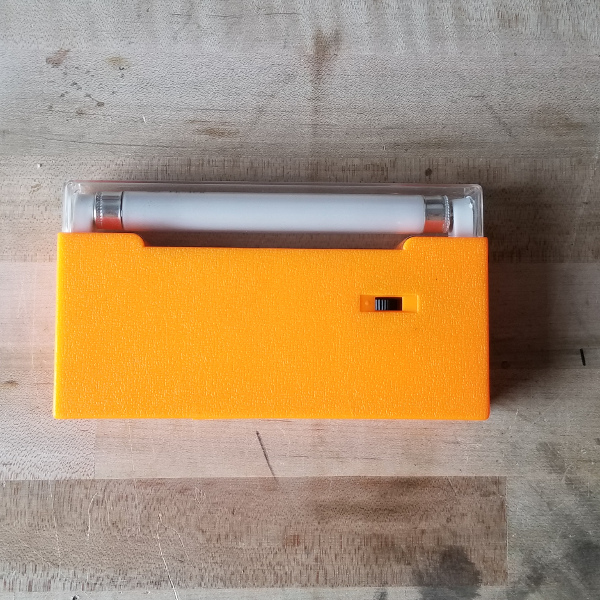
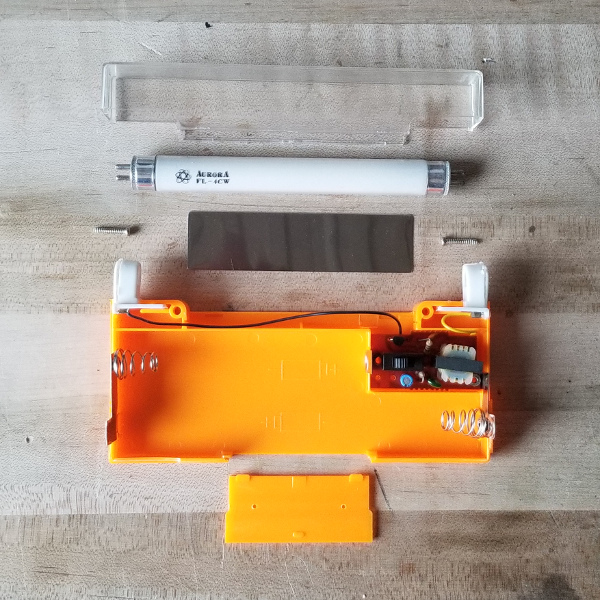
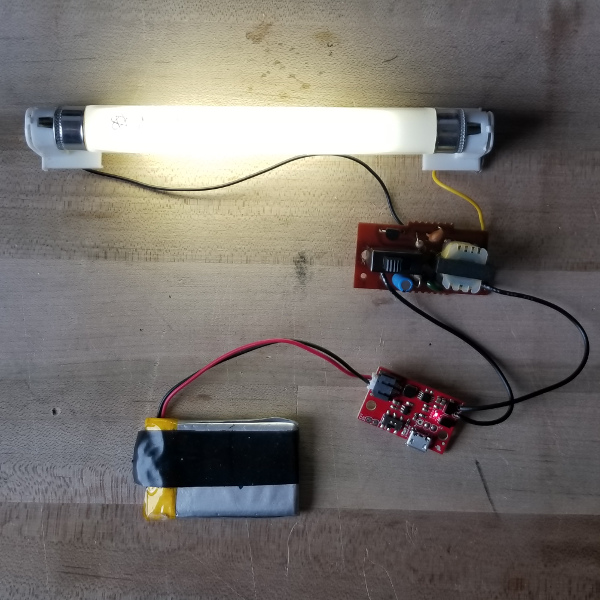
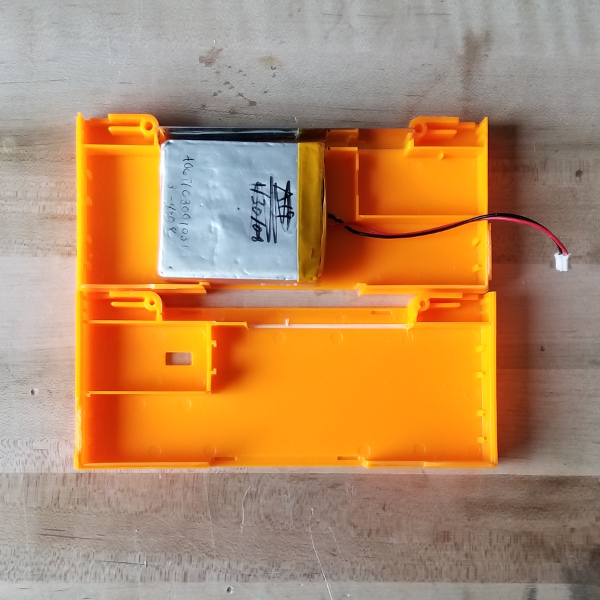


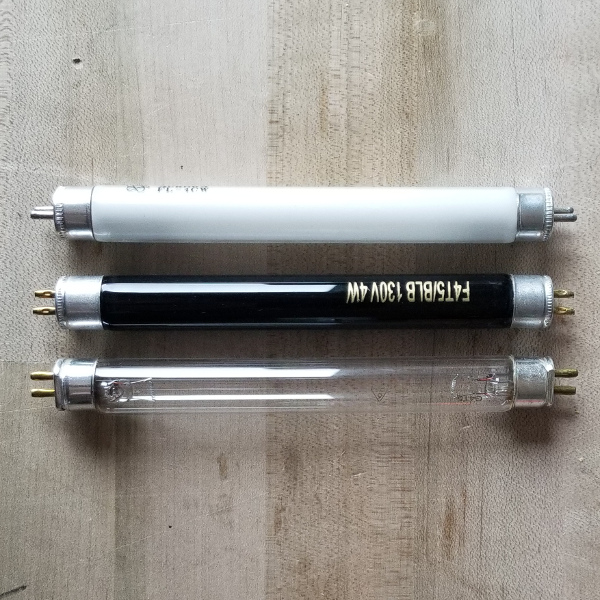

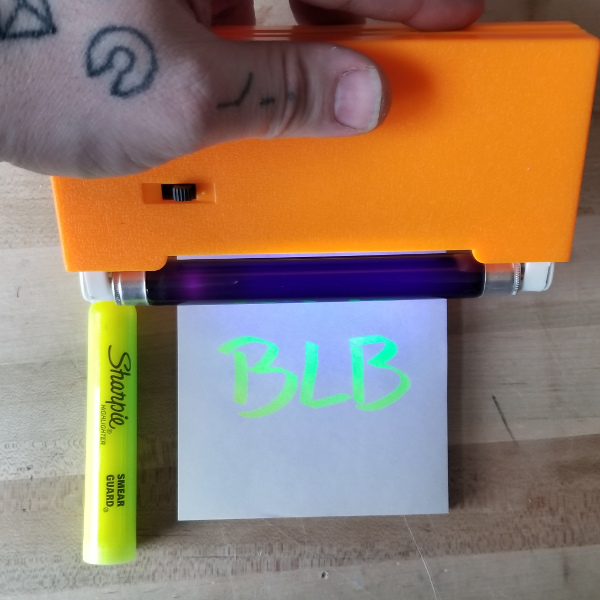
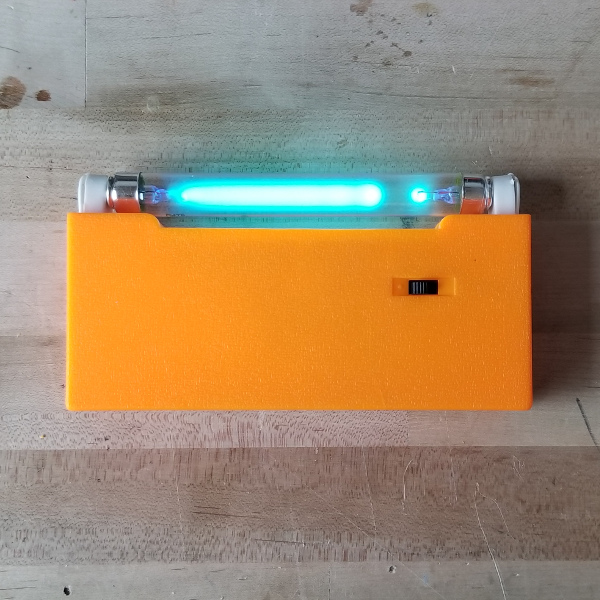
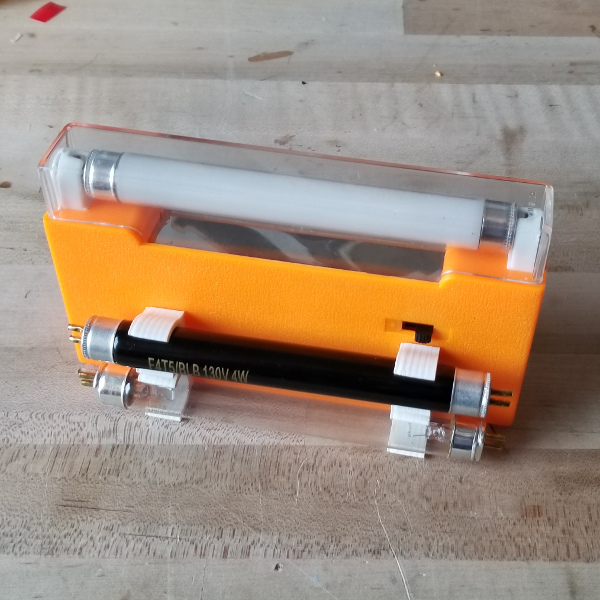
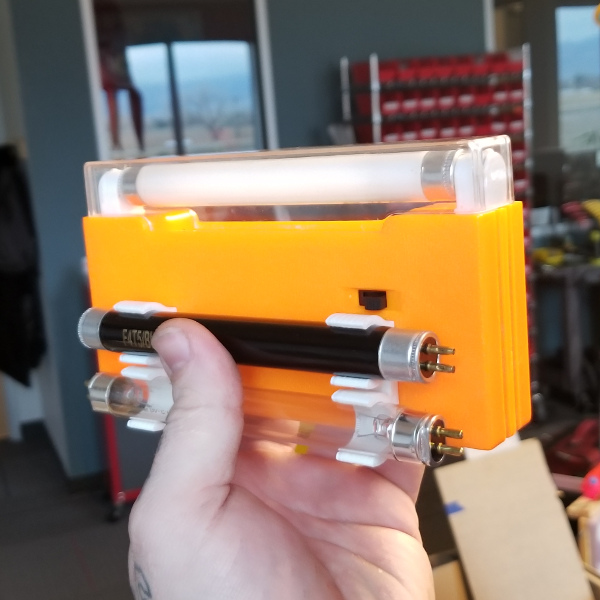






Big Clive is great! Such a gentle giant.
probably wont get answer as post is 3yrs old lol but ive bought a faulty eveready torch like this and im pretty sure the transformer is knackered (if thats what the thing wrapped in yellow tape is) but in struggling to find one like it to replace, any advice on where i can get one? all the ones in finding dont have the right number of pins
The picture of the UVC lamp has an interesting dark area. I wonder if the asymmetrical drive to the transformer is giving an asymmetrical enough waveform on the output side to drive the lamp in something like DC, so we can see the positive column, Crooke's dark space, etc. That would be cool.
Here is another interesting use for your new light, next time you are walking around there in Colorado on a dark warm night. Scorpions and Rattlesnakes will fluoresce a blueish green in response to UV light.
Click to view Wikipedia Scorpion Photo in UV
Fluorescent mineral collectors use the shorter wave UV lamps since the majority of fluorescent minerals respond only to short wave UV (UV-C). The UV lights they use add special external filters to remove the visible purple/blue light coming from the bulbs and pass only the UV, but unfortunately the short wave UV filters are a bit expensive.
Click to view an interesting Wikipedia Fluorescent Mineral Photo
They also make handheld and UV display lights for fluorescent mineral collectors with all three UV bulbs (A,B,&C) with the UV filters mounted inside the light case.
Please oh please, please stop using the [expletive deleted] pictures. (...) I have some sort of condition that totally prevents me from reading text when the graphics are just flying past. BLINK BLINK BLINK!!! HEY YOU! STOP READING AND LOOK OVER HERE!!! NO, NOT THERE, HERE!!!
It adds nothing and makes it incredibly difficult to get real information out of the site. In the 90's, it was white text with black background; now it's every possible effort to induce seizures in your audience.
What is wrong with just putting the pics IN-LINE???
Edited by moderators for 'dude, chill'
Quick tip: if you place your mouse cursor over the image carousel it will stop scrolling.
The more you know ≈≈≈≈≈★
Sorry man, I'm trying to find out if we can stop them from auto-scrolling. It really doesn't look great to me either (in fact there are quite a few of us who would like to change it). The fact is, the image carousel does look better than a bunch of 600sqpx images in line... but I agree, the motion is distracting.
Within our authoring tool, we use a markup alias to place the image carousels (which are interpreted on page load) so unfortunately, as publishers we can't adjust the parameters of the carousels unless we want to re-implement them from scratch.
It takes time to change things but your grievance has been registered.
That UV-C lamp is just what you need to erase EPROMS. I've built an eprom eraser using a longer tube made from an under the shelf type fixture that used an old school style neon bulb starter. Yeah, I guess eproms are a bit retro these days, but I still have a ton of them.
Oh, you're totally right! The heyday of eprom was before my time, so it didn't even cross my mind, but these are the right bulb for the job.
Very clever design on the clips. I would think you'd want some sort of warning or security device on the USB-C bulb, lest a coworker "borrow" the device and accidentally burn themselves. Of course, that's probably what happens when you borrow much of anything from Nick's desk...
I mean if you grab something off my desk... you gets what you gets.